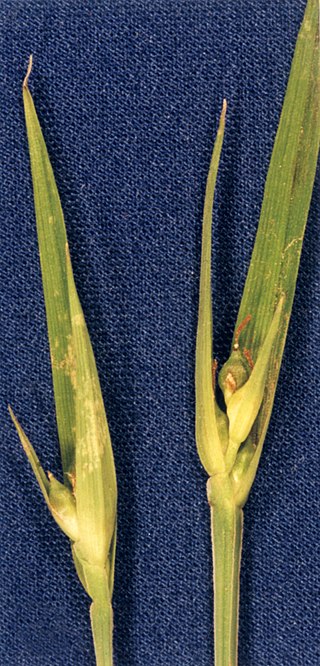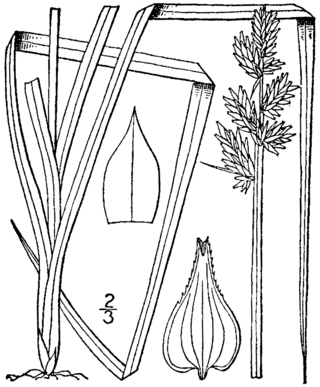
Uncinia is a genus of flowering plants in the family Cyperaceae, known as hook-sedges in Australia and as hook grasses or bastard grasses in New Zealand. The genus is characterised by the presence of a long hook formed by an extension of the rachilla, which is used to attach the fruit to passing animals (epizoochory), especially birds, and it is this feature which gives the genus its name, from the Latin uncinus, meaning a hook or barb.

Carex rossii, commonly known as Ross's sedge, is a hardy species of sedge that is often a pioneer species in areas with little or no established vegetation, or in places where disturbance has occurred. Ross's sedge grows in a variety of habitats throughout much of western North America, from Alaska to Ontario, south to New Mexico and California. It flowers in May and June.

Carex adusta, commonly known as the lesser brown sedge or the browned sedge, is a species of sedge (Carex) in the section Ovales. First described scientifically in 1839 by Francis Boott, it is found in Canada and the northeastern United States, where it grows in dry, acidic, sandy soils. Adusta is Latin for "burnt," probably referring to the color.
Carex assiniboinensis, commonly known as the assiniboia sedge, is a species of sedge (Carex) in the section Hymenochlaenae. First described scientifically in 1884 by American botanist William Boott, it is found in Canada and the United States, where it grows in floodplain forests, old river channels, riparian woodlands, and shrub thickets.

Carex backii, commonly known as Back's sedge, is a species of sedge (Carex) in the section Phyllostachyae. First described scientifically in 1839 by American botanist Francis Boott, it is found in Canada and the United States, where it grows in shaded woods, shaded slopes, and shrub thickets.

Carex alligata, the Hawaiʻi sedge, is a species of sedge that is endemic to Hawaii.
Carex aperta, known as Columbian sedge, is a species of sedge that was first described by Francis Boott in 1839. It is native to eastern Russia, northern China, western Canada, and the northwestern United States. It grows in wet meadows, along shorelines, and in other wet habitats.

Carex arctata, known as drooping woodland sedge, is a species of sedge native to eastern North America. It is sometimes called black sedge, compressed sedge, or drooping wood sedge. It occurs from Manitoba to the Maritimes in Canada, south to northwestern North Carolina, and west to Minnesota. Carex arctata grows in bogs, hardwood forests, and spruce forests.

Carex banksii is a species of flowering plant in the sedge family, Cyperaceae. Carex banksii is native to South America and was first formally named by Francis Boott in 1839.
Carex barbata is a Tasmanian species of sedge that was first formally named by Francis Boott in 1858, in his Illustrations of the genus Carex. A specimen collected in February 1839 by R. C. Gunn is the only known collection of this species. In 1909, it was reclassified as a variety of Carex gunniana, but Kew's Plants of the World Online maintains it as a separate species.
Carex bichenoviana, the plains sedge, is a species of sedge that was first formally named by Francis Boott in 1858. It is native to eastern Australia and has been introduced to New Zealand. It has previously been considered a variety of Carex pumila.

Carex conjuncta, known as soft fox sedge, is a species of sedge that was first formally named by Francis Boott in 1862. It is endemic to the central and eastern United States.
Carex gunniana is an Australia species of sedge that was first described in 1845 by Boott in the Proceedings of the Linnean Society of London. It is native to eastern Australia and Tasmania.
Carex hyalina, the tissue sedge, is a species of sedge that was first described by Francis Boott in 1847.
Carex vicinalis is a species of sedge that was first described by Francis Boott in 1867. It is native to southern India. The type specimen was collected at the Nilghiri Hills.

Carex fascicularis, commonly known as tassel sedge, is a species of sedge of the family Cyperaceae that is native to Australia, New Zealand and New Guinea.
Rusty sedge is a common name for several plants and may refer to:

Carex stipata, variously called the prickly sedge, awl-fruited sedge, awlfruit sedge, owlfruit sedge, swamp sedge, sawbeak sedge, stalk-grain sedge and common fox sedge, is a species of flowering plant in the genus Carex, native to Canada, the United States, China, Korea, Japan, and Far Eastern Russia. It is a wetland obligate.

Carex breviculmis, called the Asian shortstem sedge, is a species of flowering plant in the genus Carex, native to Asia from the Indian subcontinent to Southeast Asia, China, Taiwan, Korea, Japan, north as far as Khabarovsk Krai, and Malesia, New Guinea, Australia, Norfolk Island and New Zealand. It has been introduced to the US state of Mississippi. Typically found in forests, it is quite shade tolerant.













